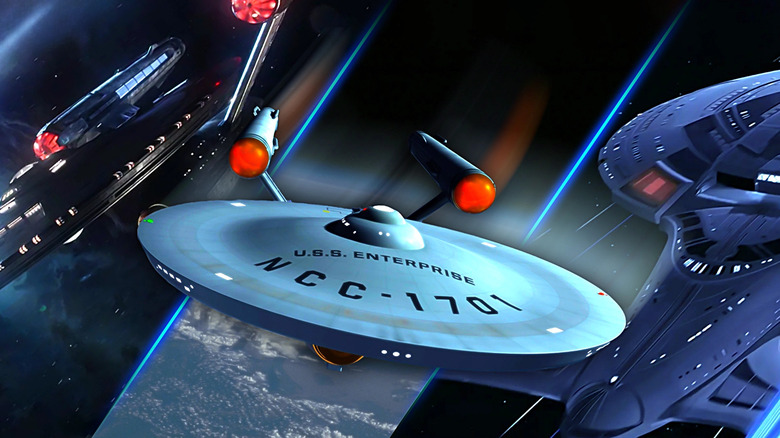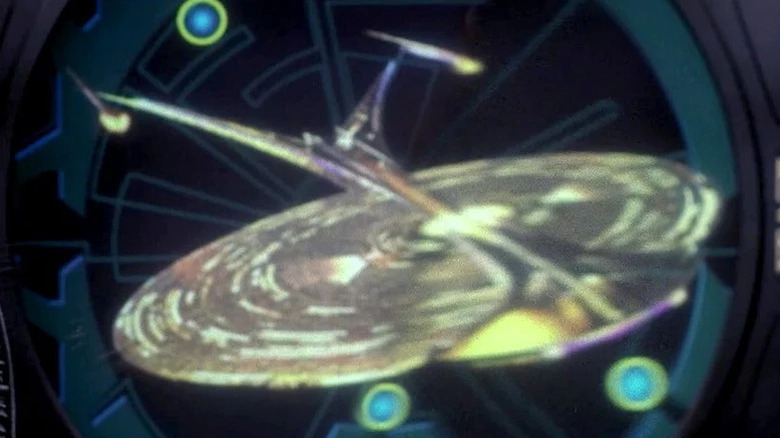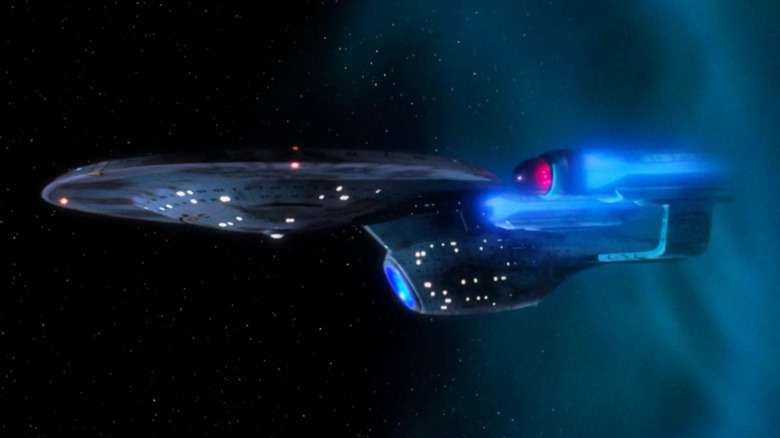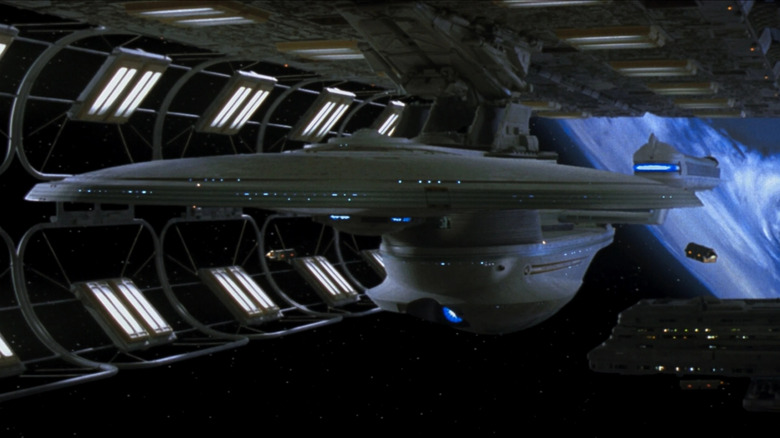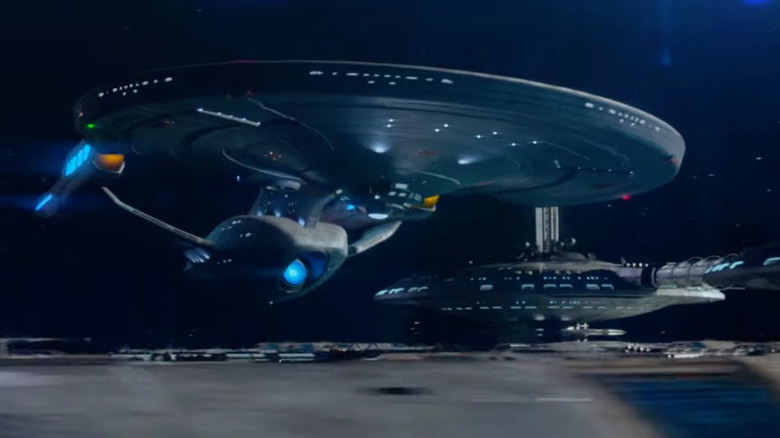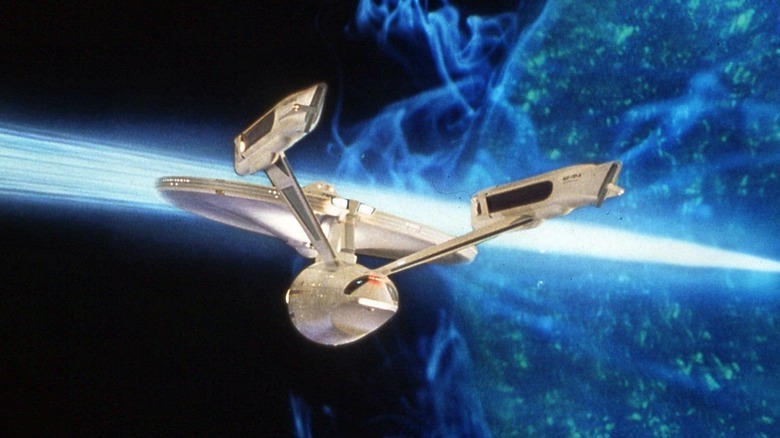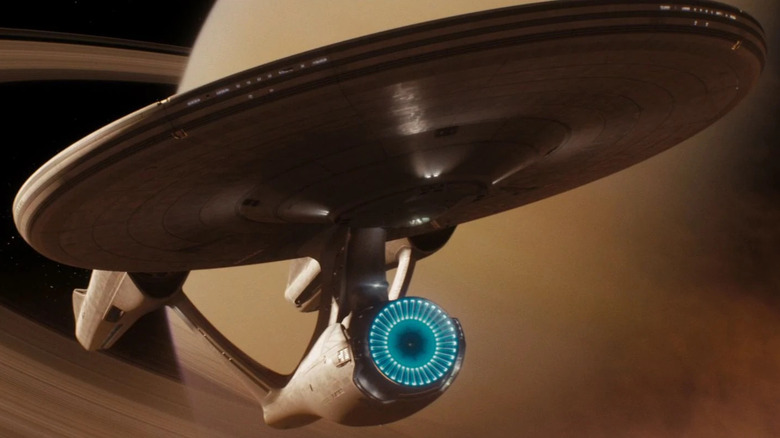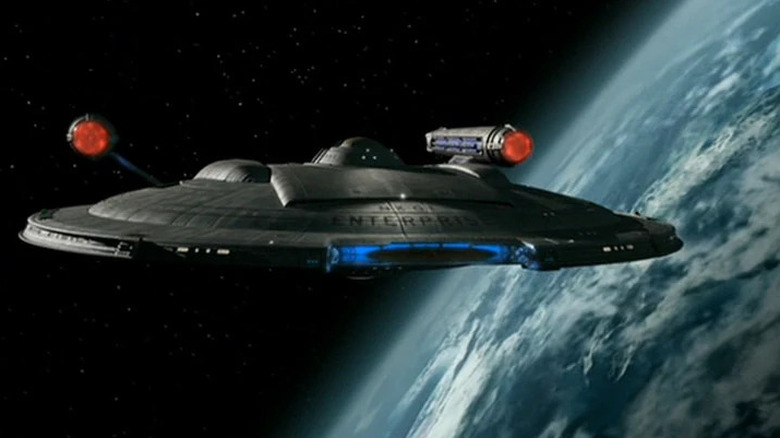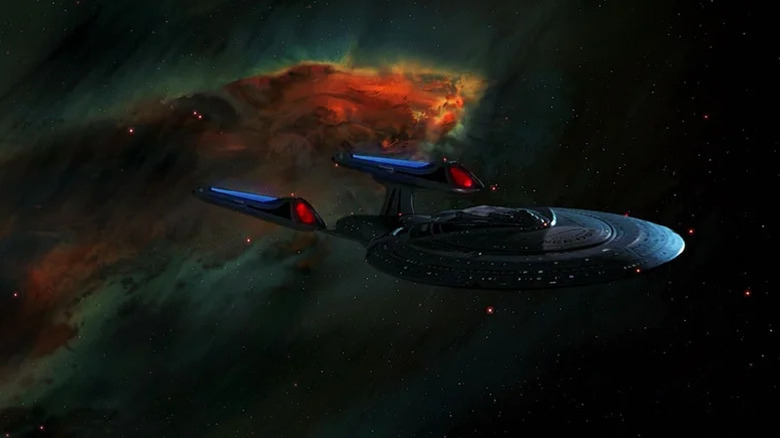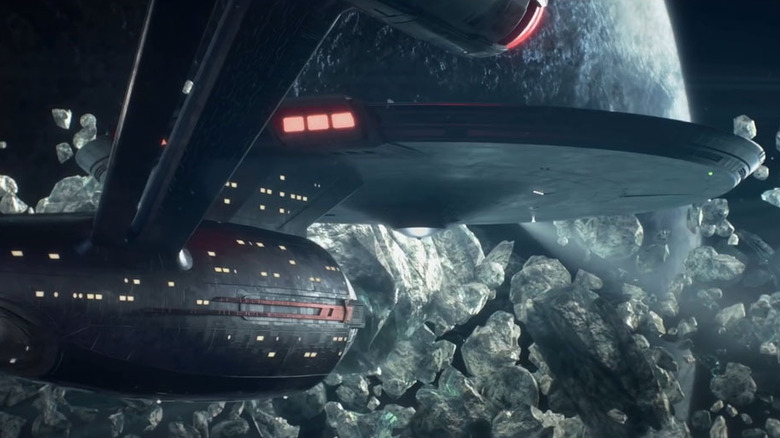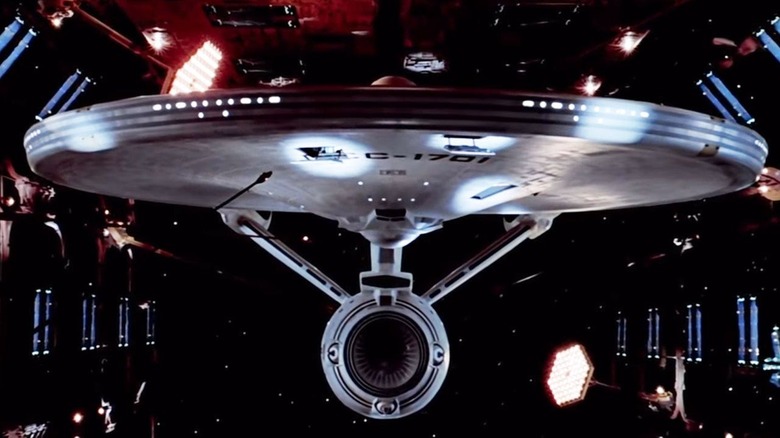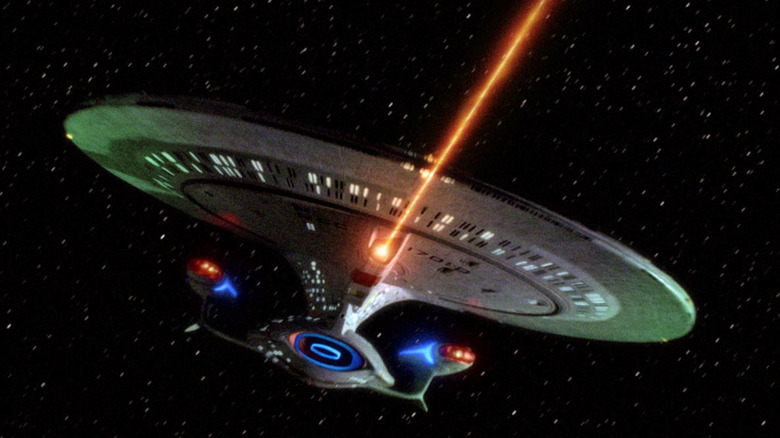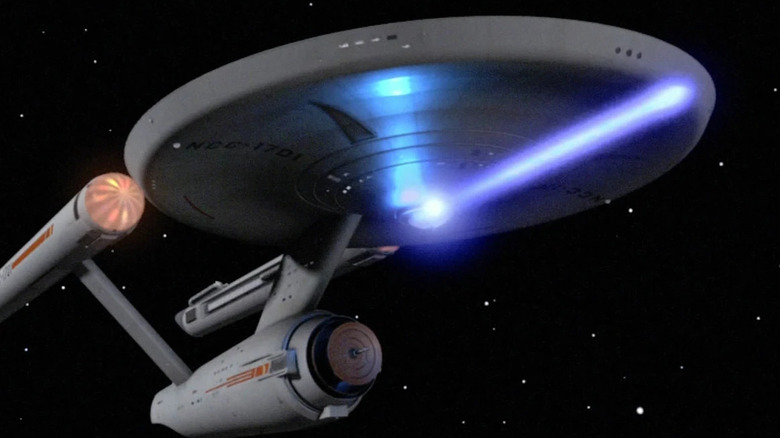Every Version Of Star Trek's Starship Enterprise, Ranked From Worst To Best
As far as starships go, there are few that are more iconic and enduring than the starship Enterprise from the "Star Trek" franchise. The flagship of Starfleet, the exploratory and military branch of the United Federation of Planets, the Enterprise boldly goes where few have ventured in the cosmos. Given the legacy of the name Enterprise in the Federation, numerous vessels across the franchise's extensive history, each with their own memorable captains and crews. Of course, even sharing the name, not all starships are created equal, and that especially includes the Enterprise.
Many of the various Enterprises have their own vocal defenders, while some have barely left an impact on the wider "Star Trek" legacy. The following list contains the multitude of Enterprises seen throughout the movies and TV shows, including differences in design and their role in the franchise's ongoing narrative. While there are time-displaced starships included, this list avoids simple one-off alternate reality redesigns, like those seen in the Mirror Universe.
Here is every version of the starship Enterprise in "Star Trek," ranked from worst to best.
USS Enterprise NCC-1701-J
While largely being a prequel to "Star Trek: The Original Series," 2001's "Star Trek: Enterprise" heavily involved time travel. One of the early overarching narratives to the series was Captain Jonathan Archer (Scott Bakula) and his crew defending their timeline from villainous interlopers, the Sphere Builders, from the far-future. This leads Archer to work with Temporal Agent Daniels (Matt Winston), who takes Archer with him 400 years into the future. During this trip, Archer and Daniels are on board the USS Enterprise NCC-1701-J observing Starfleet's final battle against the Sphere Builders.
Taking place in the third season episode "Azati Prime," not too much of the Enterprise-J is revealed. Archer and Daniels largely remain on the ship's observation deck to survey the cosmic battle, with the interior given metallic paneling and red-striped floor. Exterior shots of the Universe-class starship suggest a larger lowered saucer, with the body and warp nacelles smaller, sleeker, and further back. This limited exposure makes the Enterprise-J feel like a tease, giving viewers a glimpse of an even more futuristic ship, without actually showing what it can really do.
USS Enterprise NCC-1701-C
The 1987 revival series "Star Trek: The Next Generation" takes place approximately a century after the events of "TOS," with its main starship being the USS Enterprise NCC-1701-D. Though the Enterprise-B wouldn't be seen until the "TNG" era movies, the USS Enterprise NCC-1701-C would appear during "TNG" proper. The third season episode "Yesterday's Enterprise" had Captain Jean-Luc Picard (Patrick Stewart) and the Enterprise-D encounter a temporal rift. The crew discovers the time-displaced Enterprise-C in the rift, with their actions temporarily causing alterations to their timeline.
Given the financial realities of producing episodic television at the time and the complexity of the episode, not too much is seen of the Enterprise-C. The ship has a larger base while its warp nacelle is bridged to the body at right angles. From what the audience does see of the Enterprise-C's interior, it appears to be a darker, more spartan version of the Enterprise-D in the altered timeline. "Yesterday's Enterprise" is one of the best episodes of "TNG," but the Enterprise-C redesign isn't what elevates the show's quality.
USS Enterprise NCC-1701-B
The final "Star Trek" movie starring the cast of the original series was 1991's "Star Trek VI: The Undiscovered Country." The movie ends with the crew taking the Enterprise-A for one last joyride before the starship was decommissioned for good. So, it was only fitting that 1994's "Star Trek Generations" opens with the maiden voyage of the USS Enterprise NCC-1701-B, with Admiral James T. Kirk (William Shatner) and his friends present. Initially captained by John Harriman (Alan Ruck), the Enterprise-B's first mission becomes the beginning of Kirk's last.
The Enterprise-B's celebratory cruise is interrupted by a distress signal, with the starship moving to save refugees from a cosmic anomaly known as the Nexus. Though successful in the impromptu rescue, the ship's hull is breached and Kirk is presumably killed in action while trying to save the starship from the Nexus' volatile energies. Though described as an Excelsior-class starship, there isn't that much distinguishable about the Enterprise-B, particularly compared to the Enterprise-A. Sporting a larger and rounder body and less pronounced warp nacelles, the Enterprise-B serves as a bridge between the Enterprise-A and Enterprise-D, but is still largely forgettable.
USS Enterprise NCC-1701-G
The USS Enterprise NCC-1701-G technically appears throughout all of the third and final season of "Star Trek: Picard" but doesn't get that moniker until the series' last scenes. This starship is introduced as the USS Titan NCC-80102-A, the successor to William Riker's (Jonathan Frakes) old command ship. A Constitution III-class starship, the Titan-A is initially commanded by Captain Liam Shaw (Todd Stashwick) before being rechristened the Enterprise-G in light of its heroic actions against the Borg. In the wake of Shaw's death fighting the Borg, Seven of Nine (Jeri Ryan) is named its new captain as the ship sets off on its new mission.
Interestingly, the Enterprise-G is comparatively smaller in size than both the Enterprise-D and Enterprise-E, ostensibly making it the smallest Enterprise since the Ambassador-class Enterprise-C. The warp nacelles are larger and closer to the starship's body and saucer, making the overall ship more compactly assembled. The ship itself doesn't have much of its own personality, even before the name change, feeling more of a starship of convenience than anything else. Hopefully, if "Star Trek: Legacy" moves forward, the Enterprise-G will leave more of an impression but, for now, it's an unmemorable inclusion.
USS Enterprise NCC-1701-A
While Kirk ordered the original Enterprise to self-destruct to stop the Klingons' advance in "Star Trek III: The Search for Spock," the starship was replaced by Starfleet eventually. To reward Kirk and his unauthorized crew for saving Earth in "Star Trek IV: The Voyage Home," Starfleet unveils the USS Enterprise NCC-1701-A at the end of the movie. Kirk is demoted to captain in order to regain a command, a career change he happily accepts, with the Enterprise-A returning in the next two movies. As previously mentioned, the ship is decommissioned at the end of "The Undiscovered Country," to its crew's visible chagrin.
A Constitution II-class starship, the Enterprise-A looks nominally similar to its predecessor from the exterior. The interior of the ship is more brightly lit than the refitted Enterprise and possesses a more advanced and openly designed bridge. Throughout "Star Trek V: The Final Frontier," a questionable running joke is that the ship's systems are still malfunctioning when it is called into action. That, and the fact that the Enterprise-A always paled in comparison to its predecessor, puts it towards the bottom of this list.
USS Enterprise NCC-1701 (Kelvin Timeline)
The trilogy of "Star Trek" films taking place in the rebooted Kelvin Timeline that began in 2009 has its own distinct take on the Enterprise. In contrast to the more matte and metallic interiors, this Enterprise has a blinding white and overly lit interior, perfect for filmmaker J.J. Abrams' signature lens flares. The ship is present throughout all three movies before being destroyed at the beginning of 2016's "Star Trek Beyond" in an attack from the villainous Krall. In addition to its updated transporter effect, this Enterprise has had exterior mounted turrets making it even more formidable in combat.
Despite this added ordinance, every movie featuring the Kelvin Enterprise has the starship blasted within an inch of its existence. By the conclusion of 2013's "Star Trek Into Darkness," the ship is barely intact after its encounter with rogue Starfleet Admiral Alexander Marcus (Peter Weller). In terms of design, the brightened display makes the Enterprise feel like Starfleet picked it up from an Apple Store while its engineering bay is laughably complex. If another movie in the Kelvin Timeline ever does take place, hopefully its Enterprise will feel more fundamentally familiar.
Enterprise NX-01
The prequel series "Enterprise" explores the early days of humanity exploring the cosmos after developing warp drive, culminating in the creation of the United Federation of Planets. The story revolves around the first starship Enterprise, bearing the registry NX-01, with the ship pioneering many of Starfleet's scientific and technological advances. This gives this Enterprise a more rough-around-the-edges feel in the interior, unpolished and more industrial in its presentation. The ship has a much more pronounced saucer section, angled a bit downward behind the warp nacelles, while the deflector dish is compressed and placed on the saucer.
The NX-01 is one starship that we see get steadily upgraded over the course of the series, corresponding with humanity's own progression in the galaxy. From initially lacking a transporter to move personnel to the addition of new weapon systems and a command center, the NX-01 is the most dynamic Enterprise, in terms of design. Like the show itself, the NX-01 improved in its presentation as the series continued and found its footing. An interestingly, deliberately lo-fi take on the classic starship, the Enterprise NX-01 certainly has a personality all its own.
USS Enterprise NCC-1701-E
The first "TNG" era movie, 1994's "Star Trek Generations," ends with the scuttling of the Enterprise-D after a battle with the Klingons. This leads to the introduction of the USS Enterprise NCC-1701-E in the opening to 1996's "Star Trek: First Contact." Described by Riker as the most advanced ship in the fleet at the time, the Enterprise-E is a Sovereign-class starship that is leaner and longer than its predecessor. After repelling the Borg invasion in "First Contact," the Enterprise-E is the primary starship in 1998's "Star Trek: Insurrection" and 2002's "Star Trek Nemesis."
More combat-oriented than the Enterprise-D, the Enterprise-E has a more darkly colored exterior and a more dimly lit interior. The saucer section is depicted on the same level, if not perhaps a bit lower, than the warp nacelles to the ship's rear. To match its sleeker design, the saucer is more closely mounted to the ship's body than the Enterprise-D. While an impressive starship for the more action-packed later "TNG" movies, the Enterprise-E never quite left the same impression as its predecessor.
USS Enterprise NCC-1701 (Discovery/Strange New Worlds)
When "Star Trek" was reinvigorated by leaping to streaming in 2017, the revival series "Star Trek: Discovery" wisely refrained from including the Enterprise until the very end of season 1. Though largely similar to the original USS Enterprise NCC-1701 from the exterior, the interior of the ship is very different than it had appeared on "TOS." Under the command of Captain Christopher Pike (Anson Mount), this Enterprise has a more brightly and openly designed interior. After its appearance in the first two seasons of "Discovery," this version of the Enterprise is the primary starship in "Star Trek: Strange New Worlds."
Pike's Enterprise retains some of the design aesthetics of the USS Discovery, but has a subtly more open and friendly feel to it, matching the tone of "Strange New Worlds." Engineering and the bridge are more spacious than the "TOS" Enterprise, while the technology is visibly more advanced. There are design callbacks to the "TOS" era, specifically with its more pronounced deflector and spinning warp nacelle caps. Hopefully, as "Strange New Worlds" progresses it'll make those visual connections to the original Enterprise more clear and firmly established.
USS Enterprise NCC-1701 (Cinematic refit)
When the cast of "TOS" reunited on the big screen for 1979's "Star Trek: The Motion Picture," it did so with an appropriately cinematic update of the Enterprise. Technically just a significant refit of the USS Enterprise NCC-1701 from "TOS," Kirk returns to command his old ship to defend Earth from the cosmic anomaly V'Ger. This starship was used in the first three "Star Trek" movies before being heavily damaged in "Star Trek II: The Wrath of Khan." Never fully recovering from these skirmishes, the ship was self-destructed in "The Search for Spock" rather than letting it fall into Klingon hands.
The refit Enterprise, while presumably boasting more advanced tech, is constantly depicted in low-lit interiors, sometimes bathed in crimson light during periods when it's at red alert. Though that fits the moody, often introspective, themes within the first three "Star Trek" movies, it makes it hard to get a good look at this Enterprise's inner workings. Apart from the bridge, one of the most memorable settings on the ship is its engineering room, if only because it's adequately lit in contrast to other rooms. Still, being the main ship in the best "Star Trek" movie and helping the franchise transition to the big screen makes this version of the Enterprise particularly noteworthy.
USS Enterprise NCC-1701-D
When "TNG" brought back "Star Trek" to television, it did so with its own distinct version of the Enterprise, the USS Enterprise NCC-1701-D. Set approximately a century after the events of "TOS," Picard leads the Enterprise-D on primarily exploratory and diplomatic missions across the quadrant. A Galaxy-class starship, the Enterprise-D was designed to accommodate its crew's families through its 42 decks, providing plenty of quality-of-life amenities. The primary starship for the entirety of "TNG," the ship is scuttled in "Generations," only to make its triumphantly restored return in the final season of "Star Trek: Picard."
Compared to most other Starfleet vessels, the Enterprise-D is one of the largest starships to bear the Enterprise name. This includes an enormous saucer section, which is capable of detaching from the ship's body and warp nacelles to navigate on its own. In direct contrast to its cinematic and more modern counterparts, the Enterprise-D is also brightly and warmly lit, which is a welcome distinction. The Enterprise-D has a familiar atmosphere and personality just as memorable as any single "Star Trek" character, making it only narrowly edged out of the top spot here.
USS Enterprise NCC-1701
As with many things, there is just no topping the classic ,and that's very much the case for the original Enterprise. The USS Enterprise NCC-1701 was the primary starship in the entirety of "TOS," setting the template for all Starfleet vessels to follow, both in functionality and design. The ship has a generally well-lit interior, with matte finish walls along with many of the technological features that have come to define "Star Trek." The exterior has the iconic saucer and spinning warp nacelle layout, connected by struts and a narrow body.
From its familiar ambient noise of beeping and whirring consoles on the bridge or classic '60s interiors, the original Enterprise remains the representative starship for the franchise. "TNG" would revisit the iconic set, in the episode "Relics," while "Star Trek: Deep Space Nine" had its own salute to the Enterprise and its crew. Whenever a new starship is introduced, that first Enterprise is still the starship it's immediately compared to. The starship that launched a franchise and continues to endure for decades, the original Enterprise remains the gold standard for "Star Trek."
